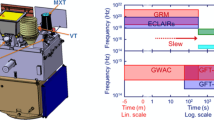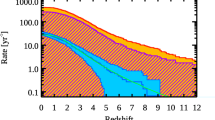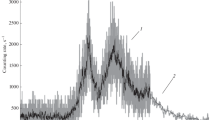Abstract
SVOM (Space-based multi-band astronomical Variable Objects Monitor) is a Sino-French space mission dedicated to the study of Gamma-Ray Bursts (GRBs) in the next decade, capable to detect and localise the GRB emission, and to follow its evolution in the high-energy and X-ray domains, and in the visible and NIR bands. The satellite carries two wide-field high-energy instruments: a coded-mask gamma-ray imager (ECLAIRs; 4–150 keV), and a gamma-ray spectrometer (GRM; 15–5500 keV) that, together, will characterise the GRB prompt emission spectrum over a wide energy range. In this paper we describe the performances of the ECLAIRs and GRM system with different populations of GRBs from existing catalogues, from the classical ones to those with a possible thermal component superimposed to their non-thermal emission. The combination of ECLAIRs and the GRM will provide new insights also on other GRB properties, as for example the spectral characterisation of the subclass of short GRBs showing an extended emission after the initial spike.







Similar content being viewed by others
Notes
We recall that the cutPL function is a subset of the Band function, obtained in the limit β →∞.
References
Amati, L., Frontera, F., Tavani, M., et al.: Intrinsic spectra and energetics of BeppoSAX gamma-ray bursts with known redshifts. Astron. Astrophys. 390, 81 (2002)
Band, D., Matteson, J., Ford, L., et al.: BATSE observations of gamma-ray burst spectra. I - Spectral diversity. Astrophys. J. 413, 281 (1993)
Barthelmy, S.D., Chincarini, G., Burrows, D.N., et al.: An origin for short gamma-ray bursts unassociated with current star formation. Nature 438, 994 (2005)
Churazov, E., Sazonov, S., Sunyaev, R., Revnivtsev, M.: arXiv astro-ph/0608252 (2006)
Crider, A., Liang, E.P., Smith, I.A., et al.: Evolution of the low-energy photon spectral in gamma-ray bursts. Astrophys. J. Lett. 479, L39 (1997)
D’Avanzo, P: Short gamma-ray bursts: a review. J. High Energy Astrophys. 7, 73 (2015)
Ghirlanda, G., Bernardini, M.G., Calderone, G., D’Avanzo, P.: Are short gamma ray bursts similar to long ones?. J. High Energy Astrophys. 7, 81 (2015)
Ghirlanda, G., Celotti, A., Ghisellini, G.: Extremely hard GRB spectra prune down the forest of emission models. Astron. Astrophys. 406, 879 (2003)
Ghirlanda, G., Ghisellini, G., Lazzati, D.: The collimation-corrected gamma-ray burst energies correlate with the peak energy of their nuF(nu) spectrum. Astrophys. J. 616, 331 (2004)
Godet, O., Nasser, G., Atteia, J.-L., et al.: In: Proceedings of the SPIE, vol. 9144, Space Telescopes and Instrumentation 2014: Ultraviolet to Gamma Ray, 914424 (2014)
Godet, O., Sizun, P., Barret, D., et al.: Monte-Carlo simulations of the background of the coded-mask camera for x- and gamma-rays on-board the Chinese-French GRB mission SVOM. Nucl. Inst. Methods Phys. Res. A 603, 365 (2009)
Gruber, D., Goldstein, A., Weller von Ahlefeld, V., et al.: The Fermi GBM gamma-ray burst spectral catalog: four years of data. Astrophys. J. Suppl. Ser. 211, 12 (2014)
Gruber, D.E., Matteson, J.L., Peterson, L.E., Jung, G.V.: The spectrum of diffuse cosmic hard x-rays measured with HEAO 1. Astrophys. J. 520, 124 (1999)
Guiriec, S., Connaughton, V., Briggs, M.S., et al.: Detection of a thermal spectral component in the prompt emission of GRB 100724B. Astrophys. J. Lett. 727, L33 (2011)
Guiriec, S., Kouveliotou, C., Daigne, F., et al.: Toward a better understanding of the GRB phenomenon: a new model for GRB prompt emission and its effects on the new L i N T- E p e a k, i r e s t, N T relation. Astrophys. J. 807, 148 (2015)
Heussaff, V., Atteia, J.-L., Zolnierowski, Y.: The E p e a k - E i s o relation revisited with Fermi GRBs. Resolving a long-standing debate?. Astron. Astrophys. 557, A100 (2013)
Kaneko, Y., Preece, R.D., Briggs, M.S., et al.: The complete spectral catalog of bright BATSE gamma-ray bursts. Astrophys. J. Supp. Ser. 166, 298 (2006)
Katz, J.I.: Low-frequency spectra of gamma-ray bursts. Astrophys. J. Lett. 432, L107 (1994)
Lacombe, K., Pons, R., Amoros, C., et al.: In: Proceedings of the SPIE, Vol. 9144, Space Telescopes and Instrumentation 2014: Ultraviolet to Gamma Ray, 914451 (2014)
Lazzati, D., Ramirez-Ruiz, E., Ghisellini, G.: Possible detection of hard x-ray afterglows of short gamma-ray bursts. Astron. Astrophys. 379, L39 (2001)
Le Provost, H., Schanne, S., Flouzat, C., et al.: arXiv:1412.0481 (2014)
Meegan, C., Lichti, G., Bhat, P.N., et al.: The Fermi Gamma-ray burst monitor. Astrophys. J. 702, 791 (2009)
Moretti, A., Pagani, C., Cusumano, G., et al.: A new measurement of the cosmic x-ray background. Astron. Astrophys. 493, 501 (2009)
Norris, J.P., Bonnell, J.T.: Short gamma-ray bursts with extended emission. Astrophys. J. 643, 266 (2006)
Preece, R.D., Briggs, M.S., Giblin, T.W., et al.: On the consistency of gamma-ray burst spectral indices with the synchrotron shock model. Astrophys. J. 581, 1248 (2002)
Preece, R.D., Briggs, M. S., Mallozzi, R.S., et al.: The synchrotron shock model confronts a “Line of Death” in the BATSE gamma-ray burst data. Astrophys. J. Lett. 506, L23 (1998)
Sazonov, S., Churazov, E., Sunyaev, R., Revnivtsev, M.: Hard x-ray emission of the Earth’s atmosphere: Monte Carlo simulations. MNRAS 377, 1726 (2007)
Schanne, S., Cordier, B., Atteia, J.-L., et al.: arXiv:1508.05851 (2015)
Schanne, S., Le Provost, H., Kestener, P., et al.: arXiv:1411.7810 (2014)
Villasenor, J.S., Lamb, D.Q., Ricker, G.R., et al.: Discovery of the short gamma-ray burst GRB 050709. Nature 437, 855 (2005)
Wei, J., Cordier, B., Antier, S., et al.: arXiv:1610.06892 (2016)
Yonetoku, D., Murakami, T., Nakamura, T., et al.: Gamma-ray burst formation rate inferred from the spectral peak energy-peak luminosity relation. Astrophys. J. 609, 935 (2004)
Yu, H.-F., van Eerten, H.J., Greiner, J., et al.: Astron. Astrophys. 583, A129 (2015)
Zhao, D., Cordier, B., Sizun, P., et al.: Exp. Astron. 34, 705 (2012)
Acknowledgements
We thank the anonymous referee for the valuable comments and suggestions. We thank V. Connaghton for helpful discussions. This work has been carried out thanks to the support of the OCEVU Labex (ANR-11-LABX-0060) and the A*MIDEX project (ANR-11-IDEX-0001-02) funded by the “Investissements d’Avenir” French government program managed by the ANR. YWD acknowledges the Youth Innovation Promotion Association CAS under Grant NO. 2014009.
Author information
Authors and Affiliations
Corresponding author
Appendix: Spectral models used in the analysis
Appendix: Spectral models used in the analysis
-
Power-law model (PL):
$$ {\mathrm{N}(\mathrm{E})=\mathrm{K} \mathrm{E}^{-\alpha}} $$(1)K = normalization [ph cm−2 s−1 keV−1 at 1 keV], α = photon index.
-
Comptonised model (cutPL):
$$ {\mathrm{N}(\mathrm{E})=\mathrm{K} \mathrm{E}^{-\alpha} \mathrm{e}^{\left( -\frac{\mathrm{E}}{ \mathrm{E}_{\circ}}\right)}} $$(2)K = normalization [ph cm−2 s−1 keV−1 at 1 keV], α = photon index, E ∘ = e-folding energy [keV].
-
Band model (Band):
$$\begin{array}{@{}rcl@{}} {\mathrm{N}(\mathrm{E})=\mathrm{K}} \left\{\begin{array}{ll} {\left( \frac{\mathrm{E}}{100~\text{keV}}\right)^{-\alpha} \mathrm{e}^{\left( -\frac{\mathrm{E}}{\mathrm{E}_{\circ}}\right)}} & {\mathrm{E}\leqslant \mathrm{E}_{\text{br}}} \\ {\left[\frac{\mathrm{E}_{\text{br}}}{100~\text{keV}}\right]^{(\beta-\alpha)} \left( \frac{\mathrm{E}}{100~\text{keV}}\right)^{-\beta} \mathrm{e}^{-(\beta-\alpha)}} & {\mathrm{E}> \mathrm{E}_{\text{br}}} \end{array}\right. \end{array} $$(3)K = normalization [ph cm−2 s−1 keV−1], α = low-energy photon index, β = high-energy photon index, E ∘ = e-folding energy [keV], Ebr = (β − α)E∘. The cutPL function is a subset of the Band function, obtained in the limit β →∞.
-
Black-body model (BB):
$$ {\mathrm{N}(\mathrm{E})= \mathrm{K} \frac{\mathrm{E}^{2}}{(\text{kT})^{4} \left[{\exp}(\mathrm{E}/(\text{kT}))-1\right]}} $$(4)K = normalization [ph keV cm−2 s−1], kT = temperature [keV].
Rights and permissions
About this article
Cite this article
Bernardini, M.G., Xie, F., Sizun, P. et al. Scientific prospects for spectroscopy of the gamma-ray burst prompt emission with SVOM. Exp Astron 44, 113–127 (2017). https://doi.org/10.1007/s10686-017-9551-4
Received:
Accepted:
Published:
Issue Date:
DOI: https://doi.org/10.1007/s10686-017-9551-4




